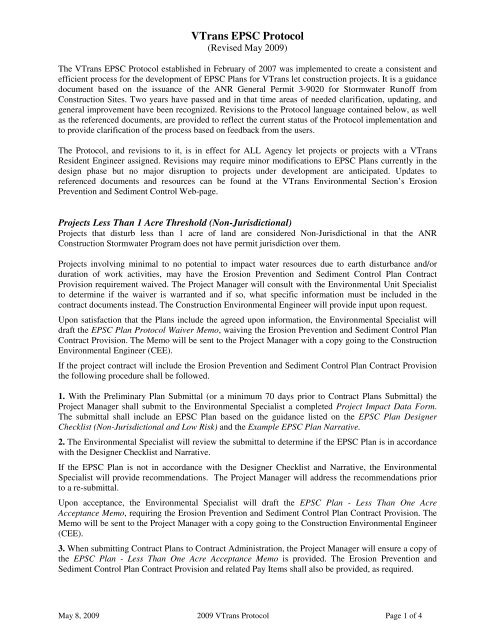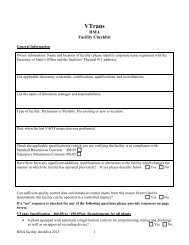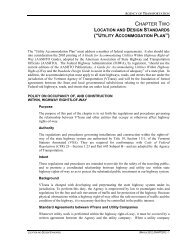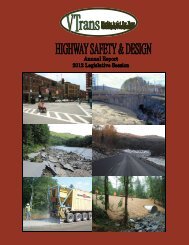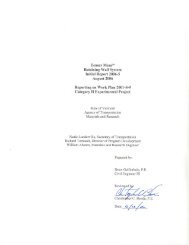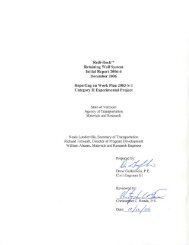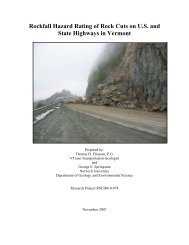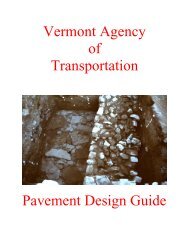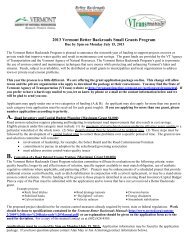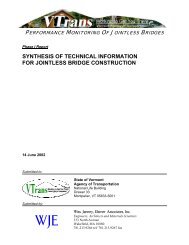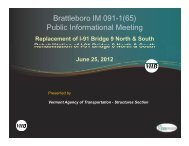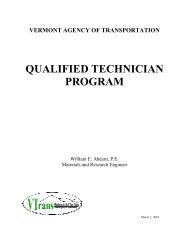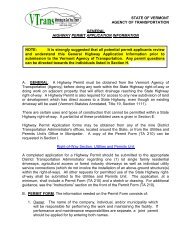VTrans EPSC Protocol - Vermont AOT Program Development
VTrans EPSC Protocol - Vermont AOT Program Development
VTrans EPSC Protocol - Vermont AOT Program Development
Create successful ePaper yourself
Turn your PDF publications into a flip-book with our unique Google optimized e-Paper software.
<strong>VTrans</strong> <strong>EPSC</strong> <strong>Protocol</strong><br />
(Revised May 2009)<br />
The <strong>VTrans</strong> <strong>EPSC</strong> <strong>Protocol</strong> established in February of 2007 was implemented to create a consistent and<br />
efficient process for the development of <strong>EPSC</strong> Plans for <strong>VTrans</strong> let construction projects. It is a guidance<br />
document based on the issuance of the ANR General Permit 3-9020 for Stormwater Runoff from<br />
Construction Sites. Two years have passed and in that time areas of needed clarification, updating, and<br />
general improvement have been recognized. Revisions to the <strong>Protocol</strong> language contained below, as well<br />
as the referenced documents, are provided to reflect the current status of the <strong>Protocol</strong> implementation and<br />
to provide clarification of the process based on feedback from the users.<br />
The <strong>Protocol</strong>, and revisions to it, is in effect for ALL Agency let projects or projects with a <strong>VTrans</strong><br />
Resident Engineer assigned. Revisions may require minor modifications to <strong>EPSC</strong> Plans currently in the<br />
design phase but no major disruption to projects under development are anticipated. Updates to<br />
referenced documents and resources can be found at the <strong>VTrans</strong> Environmental Section’s Erosion<br />
Prevention and Sediment Control Web-page.<br />
Projects Less Than 1 Acre Threshold (Non-Jurisdictional)<br />
Projects that disturb less than 1 acre of land are considered Non-Jurisdictional in that the ANR<br />
Construction Stormwater <strong>Program</strong> does not have permit jurisdiction over them.<br />
Projects involving minimal to no potential to impact water resources due to earth disturbance and/or<br />
duration of work activities, may have the Erosion Prevention and Sediment Control Plan Contract<br />
Provision requirement waived. The Project Manager will consult with the Environmental Unit Specialist<br />
to determine if the waiver is warranted and if so, what specific information must be included in the<br />
contract documents instead. The Construction Environmental Engineer will provide input upon request.<br />
Upon satisfaction that the Plans include the agreed upon information, the Environmental Specialist will<br />
draft the <strong>EPSC</strong> Plan <strong>Protocol</strong> Waiver Memo, waiving the Erosion Prevention and Sediment Control Plan<br />
Contract Provision. The Memo will be sent to the Project Manager with a copy going to the Construction<br />
Environmental Engineer (CEE).<br />
If the project contract will include the Erosion Prevention and Sediment Control Plan Contract Provision<br />
the following procedure shall be followed.<br />
1. With the Preliminary Plan Submittal (or a minimum 70 days prior to Contract Plans Submittal) the<br />
Project Manager shall submit to the Environmental Specialist a completed Project Impact Data Form.<br />
The submittal shall include an <strong>EPSC</strong> Plan based on the guidance listed on the <strong>EPSC</strong> Plan Designer<br />
Checklist (Non-Jurisdictional and Low Risk) and the Example <strong>EPSC</strong> Plan Narrative.<br />
2. The Environmental Specialist will review the submittal to determine if the <strong>EPSC</strong> Plan is in accordance<br />
with the Designer Checklist and Narrative.<br />
If the <strong>EPSC</strong> Plan is not in accordance with the Designer Checklist and Narrative, the Environmental<br />
Specialist will provide recommendations. The Project Manager will address the recommendations prior<br />
to a re-submittal.<br />
Upon acceptance, the Environmental Specialist will draft the <strong>EPSC</strong> Plan - Less Than One Acre<br />
Acceptance Memo, requiring the Erosion Prevention and Sediment Control Plan Contract Provision. The<br />
Memo will be sent to the Project Manager with a copy going to the Construction Environmental Engineer<br />
(CEE).<br />
3. When submitting Contract Plans to Contract Administration, the Project Manager will ensure a copy of<br />
the <strong>EPSC</strong> Plan - Less Than One Acre Acceptance Memo is provided. The Erosion Prevention and<br />
Sediment Control Plan Contract Provision and related Pay Items shall also be provided, as required.<br />
May 8, 2009 2009 <strong>VTrans</strong> <strong>Protocol</strong> Page 1 of 4
Projects Equal to or Greater Than 1 Acre Threshold (Jurisdictional)<br />
For those projects disturbing one or more acres, the Designer must complete the Appendix A - Risk<br />
Evaluation of Construction General Permit 3-9020 (CGP). This will determine if the proposed activities<br />
constitute Low-Risk construction activities, Moderate-Risk construction activities, or construction<br />
activities that require an Individual Permit.<br />
Low-Risk<br />
Projects that score
Moderate Risk<br />
Projects that score 1-2 on the Risk Evaluation are determined to be Moderate Risk.<br />
1. With the Preliminary Plan Submittal (or a minimum 70 days prior to Contract Plans Submittal) the<br />
Project Manager shall submit to the Environmental Specialist a completed Project Impact Data Form and<br />
the CGP NOI, Risk Evaluation, and <strong>EPSC</strong> Summary forms. There is no <strong>VTrans</strong> <strong>EPSC</strong> Plan Checklist or<br />
Example Narrative for Moderate Risk Projects. Instead, the <strong>EPSC</strong> Plan included in the Preliminary Plan<br />
Set shall be based on Appendix B of General Permit 3-9020 with guidance from Section 3 of The<br />
<strong>Vermont</strong> Standards & Specifications for Erosion Prevention & Sediment Control.<br />
The Environmental Specialist will ensure the submittal includes all necessary information in the<br />
appropriate format and forward it to the CEE for review.<br />
2. The CEE will perform a technical review of the <strong>EPSC</strong> Plan as well as the NOI, Risk Evaluation and<br />
<strong>EPSC</strong> Summary Forms and provide comments to the Project Manager and copy the Environmental<br />
Specialist. If during the review it is recognized that the project poses particular restraints that make<br />
following the standards difficult, the CEE will discuss this with the PM and schedule a consultation with<br />
an ANR Stormwater Analyst.<br />
After receiving all comments, the Project Manager will provide a re-submittal to the CEE as necessary.<br />
Upon acceptance of the <strong>EPSC</strong> Plan and supporting documents by the CEE, the Environmental Specialist<br />
will be notified and will draft the <strong>EPSC</strong> Plan for 1 or More Acres Moderate Risk Acceptance Memo,<br />
requiring the inclusion of the Erosion Prevention and Sediment Control Plan Contract Provision. The<br />
Memo will be sent to the Project Manager with a copy to the CEE.<br />
3. The Environmental Specialist will submit the Notice of Intent (NOI), Risk Evaluation, <strong>EPSC</strong> Summary<br />
Forms and <strong>EPSC</strong> Plan to ANR with copies to the Project Manager, the CEE, and to the town for posting<br />
and commencement of the 10-day public comment period.<br />
If no comments are received during the 10-day public comment period ANR will issue an authorization<br />
for coverage. The Environmental Specialist will review and distribute copies of the authorization to the<br />
Project Manager and the CEE.<br />
Any changes to the Project after this point require consultation with the Environmental Specialist to<br />
ensure the determined risk remains valid.<br />
4 -7. The remaining procedure for Moderate Risk follows Steps 4-7 described for Low Risk.<br />
Individual Permit<br />
An Individual Construction Stormwater Discharge Permit is required when a project scores out of the low<br />
and moderate risk classification in Appendix A or as required by the Secretary of ANR. It is a<br />
customized permit for discharges of stormwater from construction activities specifically tailored to the<br />
proposed construction project, and typically includes additional requirements (e.g. the oversight by an<br />
Environmental Specialist). All Individual Permits require a 30-day public comment period and have a 30-<br />
day appeal period once they are issued.<br />
The <strong>EPSC</strong> Plan development and application process for an Individual Permit is similar to that of the<br />
CGP. The same general protocol described under Moderate Risk shall be employed. However, instead of<br />
a Notice of Intent, a Permit Application Form is filed with the Risk Evaluation, <strong>EPSC</strong> Summary Forms,<br />
and Erosion Prevention and Sediment Control Plan and a consultation with ANR is mandatory. The ANR<br />
consultation shall occur when a draft of the <strong>EPSC</strong> Summary Forms and Plan are prepared.<br />
Resources<br />
VT Department of Conservation, Water Quality Division, Construction General Permit Web Page:<br />
http://www.vtwaterquality.org/stormwater/htm/sw_cgp.htm<br />
May 8, 2009 2009 <strong>VTrans</strong> <strong>EPSC</strong> <strong>Protocol</strong> Page 3 of 4
VT Agency of Transportation, Environmental Section, Erosion Prevention and Sediment Control Web<br />
Page:<br />
http://www.aot.state.vt.us/TechServices/EnvPermit/erosionpreventionandsedimentcontrol.htm<br />
May 8, 2009 2009 <strong>VTrans</strong> <strong>EPSC</strong> <strong>Protocol</strong> Page 4 of 4


